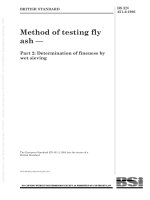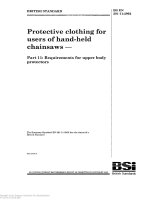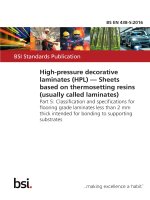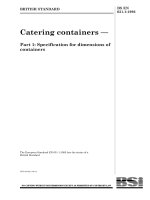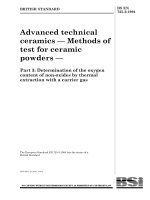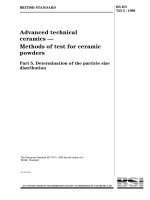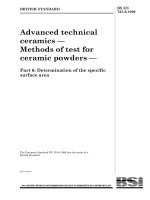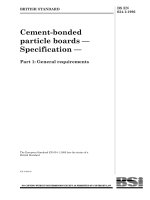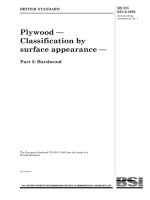Bsi bs en 00381 5 1995 (1999)
Bạn đang xem bản rút gọn của tài liệu. Xem và tải ngay bản đầy đủ của tài liệu tại đây (593.16 KB, 16 trang )
BRITISH STANDARD
Protective clothing for
users of hand-held
chain saws —
Licensed copy:HM Fire Service, 22/09/2005, Uncontrolled Copy, © BSI
Part 5: Requirements for leg protectors
The European Standard EN 381-5:1995 has the status of a
British Standard
ICS 13.340.10
BS EN 381-5:
1995
BS EN 381-5:1995
Committees responsible for this
British Standard
Licensed copy:HM Fire Service, 22/09/2005, Uncontrolled Copy, © BSI
The preparation of this British Standard was entrusted to Technical
Committee PSM/34, Clothing for protection against general hazards, upon
which the following bodies were represented:
Amalgamated Engineering Union
Association of Consulting Scientists
British Clothing Industry Association
British Leather Confederation
British Marine Industries Federation
British Mountaineering Council
British Plastics Federation
British Textile Confederation
British Textile Technology Group
Building Employers Confederation
Chartered Institute of Marketing
Chemical Industries’ Association
Chief and Assistant Chief Fire Officers’ Association
Confederation of British Wool Textiles Limited
Engineering Equipment and Materials Users’ Association
Ergonomics Society
Health and Safety Executive
Home Office
Industrial Safety (Protective Equipment) Manufacturers’ Association
Institute of Occupational Hygienists
Institute of Wastes Management
Iron and Steel Trades Confederation
London Regional Transport
Made-up Textiles Association
Ministry of Defence
National Joint Council for the Building Industry (operatives side)
SATRA Footwear Technology Centre
Textile Distributors’ Association
Textile Research Council (FCRA)
Textile Services Association Ltd.
Trades Union Congress
The following bodies were also represented in the drafting of the standard,
through subcommittees and panels:
This British Standard, having
been prepared under the
direction of the Health and
Environment Sector Board, was
published under the authority of
the Standards Board and comes
into effect on
15 November 1995
© BSI 06-1999
The following BSI references
relate to the work on this
standard:
Committee reference PSM/34
Draft for comment 90/44680 DC
ISBN 0 580 24658 2
Arboricultural Association
Association of Professional Foresters
British Chainsaw Association
Consumer Policy Committee of BSI
Department of Trade and Industry (Consumer Safety Unit, CA Division)
Forestry Commission
Garden Machinery Association
Hire Association Europe
National Association of Glove Manufacturers
National Farmers’ Union
Royal Society for the Prevention of Accidents
Safety Equipment Distributors’ Association
Timber Growers United Kingdom
Amendments issued since publication
Amd. No.
Date
Comments
BS EN 381-5:1995
Contents
Licensed copy:HM Fire Service, 22/09/2005, Uncontrolled Copy, © BSI
Committees responsible
National foreword
Foreword
Text of EN 381-5
List of references
© BSI 06-1999
Page
Inside front cover
ii
2
3
Inside back cover
i
BS EN 381-5:1995
National foreword
This British Standard has been prepared by Technical Committee PSM/34 and is
the English language version of EN 381-5:1995 Protective clothing for users of
hand-held chain saws — Part 5: Requirements for leg protectors, published by the
European Committee for Standardization (CEN).
Cross-references
Publication referred to
Corresponding British Standard
EN 381-2:1995
BS EN 381-2:1995 Protective clothing for users of
hand-held chain saws
Part 2: Test method for leg protectors
EN 381-5 was produced as a result of international discussions in which the UK
took an active part.
A British Standard does not purport to include all the necessary provisions of a
contract. Users of British Standards are responsible for their correct application.
Licensed copy:HM Fire Service, 22/09/2005, Uncontrolled Copy, © BSI
Compliance with a British Standard does not of itself confer immunity
from legal obligations.
Summary of pages
This document comprises a front cover, an inside front cover, pages i and ii,
the EN title page, pages 2 to 10, an inside back cover and a back cover.
This standard has been updated (see copyright date) and may have had
amendments incorporated. This will be indicated in the amendment table on
the inside front cover.
ii
© BSI 06-1999
EUROPEAN STANDARD
EN 381-5
NORME EUROPÉENNE
April 1995
EUROPÄISCHE NORM
ICS 13.340.10
Descriptors: Personal protective equipment, work clothing, accident prevention, protective clothing, legs, chain saws, specifications,
shock resistance, marking, technical notes
English version
Licensed copy:HM Fire Service, 22/09/2005, Uncontrolled Copy, © BSI
Protective clothing for users of hand-held chain saws —
Part 5: Requirements for leg protectors
Vêtements de protection pour utilisateurs de
scies à chne tenues à la main —
Partie 5: Exigences pour protèges-jambes
Schutzkleidung für die Benutzer von
handgeführten Kettensägen —
Teil 5: Anforderungen an Beinschutz
This European Standard was approved by CEN on 1994-12-14. CEN members
are bound to comply with the CEN/CENELEC Internal Regulations which
stipulate the conditions for giving this European Standard the status of a
national standard without any alteration.
Up-to-date lists and bibliographical references concerning such national
standards may be obtained on application to the Central Secretariat or to any
CEN member.
This European Standard exists in three official versions (English, French,
German). A version in any other language made by translation under the
responsibility of a CEN member into its own language and notified to the
Central Secretariat has the same status as the official versions.
CEN members are the national standards bodies of Austria, Belgium,
Denmark, Finland, France, Germany, Greece, Iceland, Ireland, Italy,
Luxembourg, Netherlands, Norway, Portugal, Spain, Sweden, Switzerland and
United Kingdom.
CEN
European Committee for Standardization
Comité Européen de Normalisation
Europäisches Komitee für Normung
Central Secretariat: rue de Stassart 36, B-1050 Brussels
© 1995 Copyright reserved to CEN members
Ref. No. EN 381-5:1995 E
Licensed copy:HM Fire Service, 22/09/2005, Uncontrolled Copy, © BSI
EN 381-5:1995
Foreword
Contents
This European Standard has been prepared by the
Technical Committee CEN/TC 162, Protective
clothing including hand and arm protection and
lifejackets, the secretariat of which is held by DIN.
This European Standard has been prepared under a
mandate given to CEN by the European
Commission and the European Free Trade
Association and supports essential requirements of
EU Directive 89/686/EEC.
For relationship with EU Directive[s],
see informative Annex ZA, which is an integral part
of this standard.
The Annex A is informative and contains the
selection of design A, B or C.
This European Standard shall be given the status of
a national standard, either by publication of an
identical text or by endorsement, at the latest by
October 1995, and conflicting national standards
shall be withdrawn at the latest by October 1995.
According to the CEN/CENELEC Internal
Regulations, the following countries are bound to
implement this European Standard: Austria,
Belgium, Denmark, Finland, France, Germany,
Greece, Iceland, Ireland, Italy, Luxembourg,
Netherlands, Norway, Portugal, Spain, Sweden,
Switzerland and United Kingdom.
Page
Foreword
2
0
Introduction
3
1
Scope
3
2
Normative references
3
3
Definitions
3
3.1 Leg protectors
3
3.2 Protective material
3
3.3 Protective coverage
3
3.4 Specified protective area
3
4
Designs
3
4.1 Designs of leg protectors
3
4.2 Design A
3
4.2.1 Specified protective area for design A
3
4.2.2 Other design requirements for design A
4
4.3 Design B
4
4.3.1 Specified protective area for design B
4
4.3.2 Other design requirements for design B
5
4.4 Design C
6
4.4.1 Specified protective area for design C
6
4.4.2 Other design requirements for design C
6
5
Ergonomic considerations
7
6
Requirements
7
6.1 Dimensional change
7
6.2 Protective coverage
7
6.3 Resistance to saw chain cutting
7
6.3.1 Classification according to chain speed
7
6.3.2 Requirements to cut resistance
7
6.4 Requirements to attachment of
protective padding
7
7
Changes of construction
7
8
Marking
7
9
Information for the user
7
10 Pictogram
8
Annex A (informative) Selection of
design A, design B or design C
9
Annex ZA (informative) Clauses of
this European Standard addressing
essential requirements or other provisions
of EU Directives
9
Figure 1 — Specified protective area, design A
4
Figure 2 — Specified protective area, design B
5
Figure 3 — Specified protective area, design C
6
Figure 4 — Pictogram
8
2
© BSI 06-1999
Licensed copy:HM Fire Service, 22/09/2005, Uncontrolled Copy, © BSI
EN 381-5:1995
0 Introduction
3 Definitions
This European Standard forms part of a series
concerned with personal protective equipment
designed to protect against the risks arising from
the use of hand-held chain saws.
No personal protective equipment can ensure
a 100 % protection against cutting from a hand-held
chain saw.
Nevertheless, experience has shown that it is
possible to design personal protective equipment
which offers a certain degree of protection.
Different functional principles may be applied in
order to give protection.
These include:
a) chain slipping: on contact the chain does not
cut the material;
b) clogging: fibres are drawn by the chain into the
drive sprocket and block chain movement;
c) chain braking: fibres have a high resistance to
cutting and absorb rotational energy, thereby
reducing the chain speed.
Often more than one principle is applied.
For the purposes of this standard the following
definitions apply.
1 Scope
This European Standard defines design and
specifies the requirements for leg protectors which
offers protection against cutting from a hand-held
chain saw including the requirements for
identification, marking and information for the
user.
2 Normative references
This European Standard incorporates by dated or
undated references, provisions from other
publications. These normative references are cited
at the appropriate places in the text and the
publications are listed hereafter. For dated
references, subsequent amendments to or revisions
of any of these publications apply to this European
Standard only when incorporated in it by
amendment or revision. For undated references the
latest edition of the publication referred to applies.
EN 381-2:1995, Protective clothing for users of
hand-held chain saws — Part 2: Test methods for leg
protectors.
© BSI 06-1999
3.1
leg protectors
any type of protective garment which protects at
least the specified protective area to the level of
resistance specified within this standard for the leg,
e.g. trousers, leggings, etc.
3.2
protective material
material which is designed to protect the wearer
against the cutting effect of the hand-held chain
saw. This protective material may include the cloth
of the garment
3.3
protective coverage
the area of the garment which is covered by
protective material
3.4
specified protective area
the required protective coverage
4 Designs
4.1 Designs of leg protectors
This standard defines three designs, design A,
design B and design C for leg protectors. Design A,
design B and design C have different specified
protective areas as stated in 4.2, 4.3 and 4.4.
4.2 Design A
4.2.1 Specified protective area for design A
The specified protective area for design A is
described under a), b) and c) and is shown
in Figure 1.
a) Front. The specified protective area fully
covers the front of the garment from 50 mm
above the lower end of the legs to 200 mm above
the crotch. It is allowed to leave out protective
material at the fly.
b) Rear, left leg. The specified protective area
covers on the outer side of the leg a 50 mm wide
strip extending from 50 mm above the lower end
of the leg to 200 mm below the crotch and then
tapering to zero at a height of 200 mm above the
crotch.
c) Rear, right leg. The specified protective area
covers on the inner side a 50 mm wide strip
from 50 mm from the bottom of the leg to 50 mm
below the crotch.
3
Licensed copy:HM Fire Service, 22/09/2005, Uncontrolled Copy, © BSI
EN 381-5:1995
Figure 1 — Specified protective area, design A
It is allowed to extend the protective coverage,
under the condition that the protection level is at
least the same as in the specified protective area.
There shall be no joins in the protective material
within the specified protective area.
4.2.2 Other design requirements for design A
The leg protectors shall have a specified protective
area as identified in 4.2.1 and they shall fully
enclose both the front and the rear of the user’s leg
from 50 mm below the crotch to the bottom end of
the garment legs. The bottom end of each garment’s
leg shall be designed to facilitate easy overlap of
protective material with safety footwear worn by the
user.
4
4.3 Design B
4.3.1 Specified protective area for design B
The specified protective area for design B is
described under a), b) and c) and is shown
in Figure 2.
a) Front. The specified protective area fully
covers the front of the garment from 50 mm
above the lower end of the legs to 200 mm above
the crotch. It is allowed to leave out protective
material at the fly.
© BSI 06-1999
EN 381-5:1995
Licensed copy:HM Fire Service, 22/09/2005, Uncontrolled Copy, © BSI
b) Rear, left leg. The specified protective area
covers on the inner side of the leg a 50 mm wide
strip from 50 mm from the bottom to 50 mm
below the crotch. On the outer side of the leg it
covers a 50 mm wide strip extending from 50 mm
above the lower end of the leg to 200 mm below
the crotch and then tapering to zero at a height
of 200 mm above the crotch.
c) Rear, right leg. The specified protective area
covers on the inner side a 50 mm wide strip
from 50 mm from the bottom of the leg to 50 mm
below the crotch.
It is allowed to extend the protective coverage,
under the condition that the protection level is at
least the same as in the specified protective area.
There shall be no joins in the protective material
within the specified protective area.
4.3.2 Other design requirements for design B
The leg protectors shall have a specified protective
area as identified in 4.3.1 and they shall fully
enclose both the front and the rear of the user’s leg
from 50 mm below the crotch to the bottom end of
the garment legs. The bottom end of each garment’s
leg shall be designed to facilitate easy overlap of
protective material with safety footwear worn by the
user.
Figure 2 — Specified protective area, design B
© BSI 06-1999
5
EN 381-5:1995
4.4 Design C
4.4.1 Specified protective area for design C
Licensed copy:HM Fire Service, 22/09/2005, Uncontrolled Copy, © BSI
The specified protective area for design C is
described under a) and b) and is shown in Figure 3.
a) Front. The specified protective area fully
covers the front of the garment from 50 mm
above the lower end of the legs to 200 mm above
the crotch. It is allowed to leave out protective
material at the fly.
b) Rear. The specified protective area fully covers
the rear of the garment from 50 mm above the
lower end of the legs to 50 mm below the crotch
on the inner side of each leg and to the level of the
crotch on the outside of each leg.
No more than two joins are allowed in the protective
material.
No gaps shall be more than 4 mm wide, and shall
run along the leg.
4.4.2 Other design requirements for design C
The bottom end of each garment’s leg shall be
designed to facilitate easy overlap of protective
material with chain saw protective footwear worn
by the user.
Figure 3 — Specified protective area, design C
6
© BSI 06-1999
Licensed copy:HM Fire Service, 22/09/2005, Uncontrolled Copy, © BSI
EN 381-5:1995
5 Ergonomic considerations
8 Marking
The protective clothing shall be as lightweight as
possible.
Between crotch and fly a break of 30 mm is allowed,
but it is recommended to keep this break as small as
possible.
The design shall be without appendages, which
could become entangled in the machinery or
undergrowth.
Braces shall have a minimum width of 30 mm.
The construction around the knee shall facilitate
bending of the leg.
If the leg protectors are leggings they shall be
capable of being securely connected in the fly area.
For zippers, buttons, etc. an opening break
of 30 mm is allowed.
Protective clothing for users of hand-held chain
saws shall be durably marked at least with the
following information.
a) Name or trade mark or other means of
identification of the manufacturer or legally
responsible company.
b) Designation or style no. (company
identification of model).
c) Design according to clause 4.
d) Serial number/batch number.
e) Date of manufacture (year and month).
f) The number EN 381-5.
g) Size designation.
h) Speed classification. This information shall be
given outside the frame of the pictogram showing
a chain saw, preferably on the bottom of the
frame.
i) The sentence “If the protective material is
damaged, the garment is to be discarded”, or
similar.
j) Washing/cleaning instructions including
warnings against incorrect treatment.
6 Requirements
6.1 Dimensional change
The dimensional change as measured in accordance
with clause 6 of EN 381-2:1995 shall be less
than 6 %.
6.2 Protective coverage
The protective coverage measured in accordance
with clause 7 of EN 381-2:1995 shall fulfil the
requirements given in 4.2 for design A, 4.3 for
design B or 4.4 for design C.
6.3 Resistance to saw chain cutting
6.3.1 Classification according to chain speed
Testing according to this standard can be made with
the following three speeds with classes designated
as follows:
class 1:
20 m/s;
class 2:
24 m/s; and
class 3:
28 m/s.
6.3.2 Requirements to cut resistance
When tested according to clause 8 of EN 381-2:1995
no cut through is allowed in any tested specimen.
6.4 Requirements to attachment of protective
padding
The protective material shall be permanently
attached to the garment. For A and B it shall be
along the edges of the protective padding along the
leg. When tested according to clause 9 of
EN 381-2:1995 the attachment should resist at least
a force of 200 N.
7 Changes of construction
9 Information for the user
Protective clothing for users of hand-held chain
saws shall be supplied with unambiguous
information for the user, in the language(s) of the
country of purchase. The information for the user
shall at least contain the following.
a) The information given in the marking.
b) Name, address and telephone number of
manufacturer or legally responsible company.
c) Instructions to reshape when wet after each
washing.
d) Instructions for correct use.
e) Instruction for allowable alterations for
personal fit.
f) Instructions about repair of the garment
especially pointing out that the protective
material cannot be repaired.
g) Instruction that the protective area and
material must not be altered in any way and that
once cut into, the garment should be discarded.
h) Criteria for discarding the garment.
i) The text “Does not offer protection against all
risks” or similar.
j) Weight of garment to the nearest 100 g related
to size.
The manufacturer can change the construction
above the waist level without retesting the type.
© BSI 06-1999
7
EN 381-5:1995
10 Pictogram
Licensed copy:HM Fire Service, 22/09/2005, Uncontrolled Copy, © BSI
Protective clothing fulfilling this standard shall be
marked with the pictogram shown in Figure 4. The
pictogram shall be placed at any visible place on the
clothing and have minimum size 30 mm × 30 mm.
Figure 4 — Pictogram
8
© BSI 06-1999
EN 381-5:1995
Annex A (informative)
Selection of design A, design B or design C
The designs A and B are, e.g., meant to be used in normal forest harvesting work by professional loggers
who are thoroughly trained and instructed.
Design B is similar to design A, but the coverage is extended 50 mm on the inner side of the left leg. The
background for this extension is that in this area, the leg artery is situated. If this artery is damaged, the
accident may become fatal due to loss of blood. Design A is supposed to be more comfortable than design B.
Design C is, e.g., to be used by persons who are not normally working with chain saws or in exceptional
situations, e.g. when working in trees.
The 50 mm garment at the bottom of the leg protectors is intended for personal fit with footwear
(see prEN 345-2) giving protection against chain saw cutting. An overlap of 50 mm is recommended.
Licensed copy:HM Fire Service, 22/09/2005, Uncontrolled Copy, © BSI
Annex ZA (informative)
Clauses of this European Standard addressing essential requirements or other
provisions of EU Directives
This European Standard has been prepared under a mandate given to CEN by the European Commission
and the European Free Trade Association and supports essential requirements of
EU Directive 89/686/EEC.
WARNING. Other requirements and other EU Directives may be applicable to the product(s) falling within
the scope of this standard.
The following clauses of this standard are likely to support requirements of Directive 89/686/EEC,
Annex II.
Compliance with the clauses of this standard provides one means of conforming with the specific essential
requirements of the Directive concerned and associated EFTA regulations.
EU-Directive 89/686/EEC, Annex II
Clauses of this standard
1.1 Design principles
5
1.3 Comfort and efficiency
4
1.4 Information supplied by the manufacturer
8 and 9
2.2 PPE “enclosing” the parts of the body to be protected
4 and 6
2.12 PPE bearing one or more identification or recognition marks directly
or indirectly relating to health and safety
8 and 9
3.3 Protection against physical injury
4 and 6
© BSI 06-1999
9
Licensed copy:HM Fire Service, 22/09/2005, Uncontrolled Copy, © BSI
10
blank
BS EN 381-5:1995
List of references
Licensed copy:HM Fire Service, 22/09/2005, Uncontrolled Copy, © BSI
See national foreword.
© BSI 06-1999
BS EN 381-5:
1995
BSI — British Standards Institution
BSI is the independent national body responsible for preparing
British Standards. It presents the UK view on standards in Europe and at the
international level. It is incorporated by Royal Charter.
Revisions
British Standards are updated by amendment or revision. Users of
British Standards should make sure that they possess the latest amendments or
editions.
It is the constant aim of BSI to improve the quality of our products and services.
We would be grateful if anyone finding an inaccuracy or ambiguity while using
this British Standard would inform the Secretary of the technical committee
responsible, the identity of which can be found on the inside front cover.
Tel: 020 8996 9000. Fax: 020 8996 7400.
BSI offers members an individual updating service called PLUS which ensures
that subscribers automatically receive the latest editions of standards.
Licensed copy:HM Fire Service, 22/09/2005, Uncontrolled Copy, © BSI
Buying standards
Orders for all BSI, international and foreign standards publications should be
addressed to Customer Services. Tel: 020 8996 9001. Fax: 020 8996 7001.
In response to orders for international standards, it is BSI policy to supply the
BSI implementation of those that have been published as British Standards,
unless otherwise requested.
Information on standards
BSI provides a wide range of information on national, European and
international standards through its Library and its Technical Help to Exporters
Service. Various BSI electronic information services are also available which give
details on all its products and services. Contact the Information Centre.
Tel: 020 8996 7111. Fax: 020 8996 7048.
Subscribing members of BSI are kept up to date with standards developments
and receive substantial discounts on the purchase price of standards. For details
of these and other benefits contact Membership Administration.
Tel: 020 8996 7002. Fax: 020 8996 7001.
Copyright
Copyright subsists in all BSI publications. BSI also holds the copyright, in the
UK, of the publications of the internationalstandardization bodies. Except as
permitted under the Copyright, Designs and Patents Act 1988 no extract may be
reproduced, stored in a retrieval system or transmitted in any form or by any
means – electronic, photocopying, recording or otherwise – without prior written
permission from BSI.
This does not preclude the free use, in the course of implementing the standard,
of necessary details such as symbols, and size, type or grade designations. If these
details are to be used for any other purpose than implementation then the prior
written permission of BSI must be obtained.
BSI
389 Chiswick High Road
London
W4 4AL
If permission is granted, the terms may include royalty payments or a licensing
agreement. Details and advice can be obtained from the Copyright Manager.
Tel: 020 8996 7070.
